By Natalie Martins / January 11, 2017 August 23, 2022 / Gear
Spend $10 and 15 minutes in your garage and save hours repairing and patching flats. Slime Tire Sealant is a lifesaver.
RATING: Exceptional
MSRP: $10
BEST FOR: Everyone! Spend $10 and 15 minutes in your garage and save hours repairing and patching flats.
View on Amazon
PROS:
CONS:
Flat tires are a pain. Not only are they frustrating for kids and parents, they often sideline a bike for weeks. Fortunately, preventing flats is as simple as spending $8 at Walmart (or $10 on Amazon) and 15 minutes in the garage. Tire sealants is essentially a fiber-filled “slime” that coats the inside of a bike tube to quickly and efficiently repair and prevents flats. In most cases, Slime only needs to be added to a tire once and prevents flats for essentially the life of the tire or tube.
In the four years we have been using Slime in our kid’s bike tires, we have only experienced one flat after our son rode through a field of thorny weeds. Honestly, with all the bike riding that gets done around here, I can’t imagine life without tire sealant! The most widely available brand is Slime and is sold at Walmart, Target, most automotive parts store and Amazon. You only need about 2 oz. of slime per 12″ tire, so the 8 oz. bottle sold in the bicycle section is sufficient for two bikes. If you have several bikes to seal, consider heading over to the automotive department where the Slime tends to be cheaper by the ounce.
In order to add the Slime you will need to remove all the air out of the tire, so be sure to have a bike pump nearby before you start.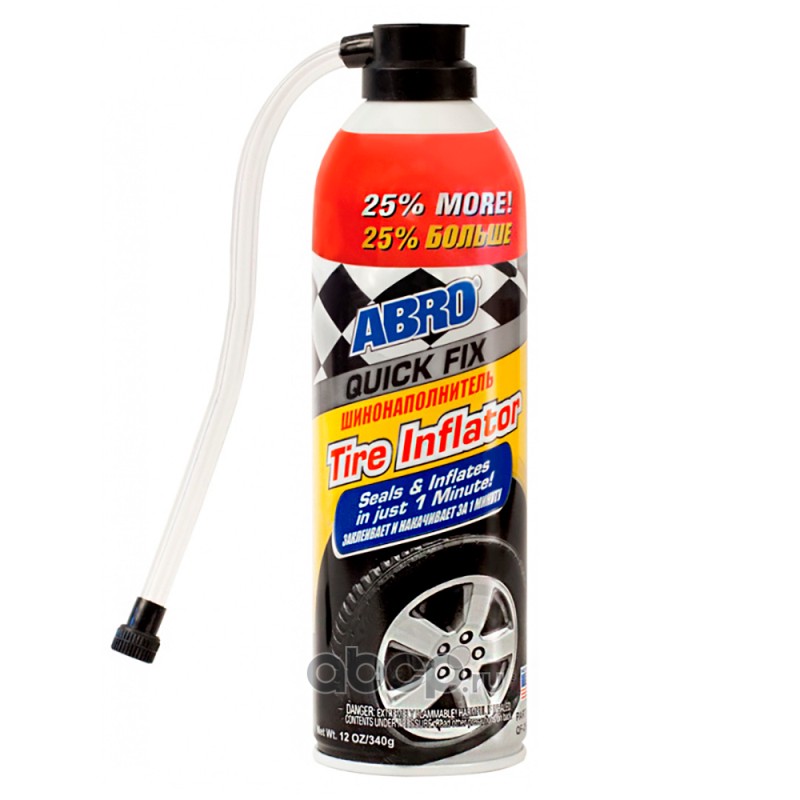
The inner valve of the tire stem valve must first be removed before you can add any slime. While it sounds daunting, it is actually quite easy to remove using the included tool.
Once the valve is out, it’s time to add the Slime. You will need to add about 2 oz. to a 12″ tire (1/4 cup) and about 2.5 oz. for a 16″ tire. For larger tires a chart is given on the back of the slime container.
Once the Slime is in place, use the tool to re-insert the core. Next, inflate the tire to the correct PSI (listed on tire sidewall) and then spin the wheel to allow the Slime to evenly distribute throughout the tire.
Repeat steps with the second tire and then you are ready to ride. Slime does not require any waiting period, allowing the bike to be used right away.
FTC Disclosure:Affiliate links are included in this review. No monetary compensation was provided for this review. The product reviewed was purchased by Two Wheeling Tots and not supplied by the manufacturer. All opinions and images are that of Two Wheeling Tots LLC. All content and images are copyrighted and should not be used or replicated in any way. View our Terms of Use.
No monetary compensation was provided for this review. The product reviewed was purchased by Two Wheeling Tots and not supplied by the manufacturer. All opinions and images are that of Two Wheeling Tots LLC. All content and images are copyrighted and should not be used or replicated in any way. View our Terms of Use.
So you punctured your bicycle’s tire—whether a clincher tire with an inner tube or tubeless tire without a tube—and you’re wondering if Slime sealant is a good fix or not.
Should You Use A Magic Eraser on Le...
Please enable JavaScript
Should You Use A Magic Eraser on Leather
It’s a good question. After all, good tires don’t come cheap, and you want to weigh the pros and cons of sealing the tire versus replacing it. So let’s not waste any more time in formalities and help you decide.
Slime sealant does work on bike tires, clinchers and tubeless, and it can help you fix small to medium punctures with ease. It doesn’t work on big holes, but it can seal flint and thorn punctures for up to 2 years.
It doesn’t work on big holes, but it can seal flint and thorn punctures for up to 2 years.
Let’s find out a bit more about how Slime’s sealants work, and how they prevents and repair punctures on bike tires.
Slime sealant works in a clever way to both repair small punctures when you get them and reduce the risk of punctures as a whole.
How does it work?
Well, the sealant comes as a liquid, without any air in it. When you connect the sealant’s bottle to the tire’s valve and pump some sealant in, the liquid gets carried to the punctures thanks to the force of the escaping air.
As the liquid sets, it coats the inside of the tube or tire as it’s rotated, creating a mechanical seal that plugs up holes up to 1/8″ (3mm) big. There isn’t any chemical reaction and there’s no need to try to glue it or fasten it in place; the sealant does all the work for you.
What I like the most about Slime’s sealants is that they work at extreme temperatures.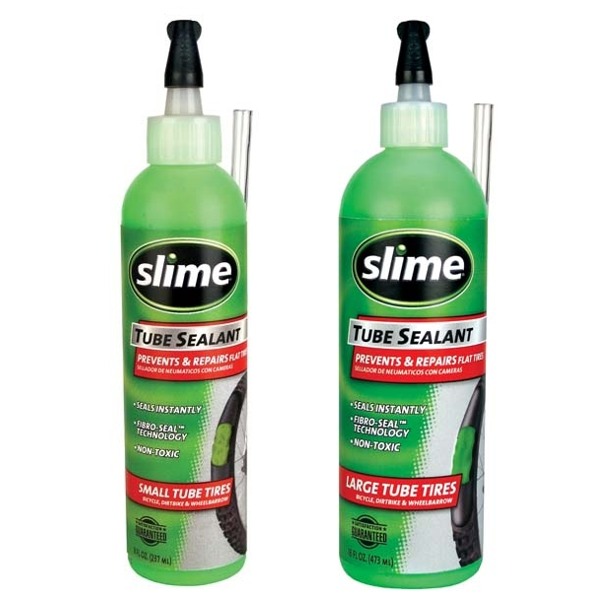 The sealant’s freezing point is said to be -35°F (-37°C) and it’s separation point is 182°F (82°C).
The sealant’s freezing point is said to be -35°F (-37°C) and it’s separation point is 182°F (82°C).
So there’s virtually no chance it will freeze or melt on you. (If you can ride a bike in these extremes, more power to you!) I’ve used it time and time again when I need to and, as long as the hole wasn’t too big, it has always worked.
This all works because the sealant consists of fibers, rubber, and a few other ingredients that, when the air tries to rush out of the tire through the puncture, get pushed into the hole. This creates a seal that fits the hole perfectly and makes it airtight for up to 2 years, without the need for tape, glue, or patches.
It can also make your tube more durable, because there will be a second inner coating, which makes it harder for sharp objects to puncture the tire. They will have to go through the outer tire, the inner tube, and the layer of Slime before they will start to cause air leakage.
So, if you want your tires to last longer, Slime’s stuff is a great option.
Slime makes sealants design to work with all kinds of cars, motorbike, and bicycle tires. For the same reasons, before you buy and use Slime to seal holes in your bike’s tires, you need to make sure to use the right kind.
There’s one Slime Tube Repair Sealant, as well as a Slime 2-in-1 Sealant for tubeless tire and tube repair.
They’re not necessarily interchangeable, so be sure to choose the right type for your bike’s tires.
Choosing is as easy as pie: If you have clincher or tubular tires, get the special Slime for repairing tubes. If you have tubeless tires (or one tubeless and one with an inner tube), get the universal Slime.
For starters, position your bike on a flat, stable surface and hold it upright so it won’t fall over or fall on you while you’re working.
Second, lift the wheel that needs repairing, and turn it so that the valve is in the upper half of the tire. When you’re filling the tire with sealant, you want the bottle to be upright. This isn’t critical, but Slime’s instructions say it will make the sealant work better.
When you’re filling the tire with sealant, you want the bottle to be upright. This isn’t critical, but Slime’s instructions say it will make the sealant work better.
When the wheel is in position, take off the valve’s cap, then remove the valve core.
For the valve core, the bottle has a tool for this incorporated into the black cap for whenever you’re on the road or out in the wild. Simply use this to engage the valve core so that air can escape from the tire. You may or may not need to put in some elbow grease here.
Gradually deflate the tire. The flatter it is, the better the Slime will work, so be patient and take the time to do this well. Once the air is all out, set the valve core down somewhere safe. If your tire has been punctured by something, make sure to remove the sharp item before proceeding.
Remove the Slime’s seal and reattach the white cap to the Slime bottle. Then, attach the clear tube to the cap. You need to slot the other end of the tube into the valve stem so that you can start squeezing the tube and filling the tire with slime.
Most bikes need about 4 oz of Slime per tire, but, if you’re someone who likes precision, you can use an online calculator or the Slime chart (on the bottle) to calculate this. When you have finished, restore the valve cap, pump the tire up to the recommended pressure, and spin the tire several times to distribute the Slime inside.
This should seal the puncture and help to prevent further punctures, and it is pretty straightforward to do!
Slime can work pretty well for up to 2 years. But, in the long term, it isn’t a replacement for a new tube or tubeless tire. It doesn’t repair the hole per se; it just fills it up with fibrous material. Over time, it will wear out and the tire will start to deflate again.
You can certainly use Slime as a long term fix if you choose to, but be aware that it simply won’t last forever, and you will need to take action to repair the tire properly. Other sealants on the market may not be as easy to apply, but may also work.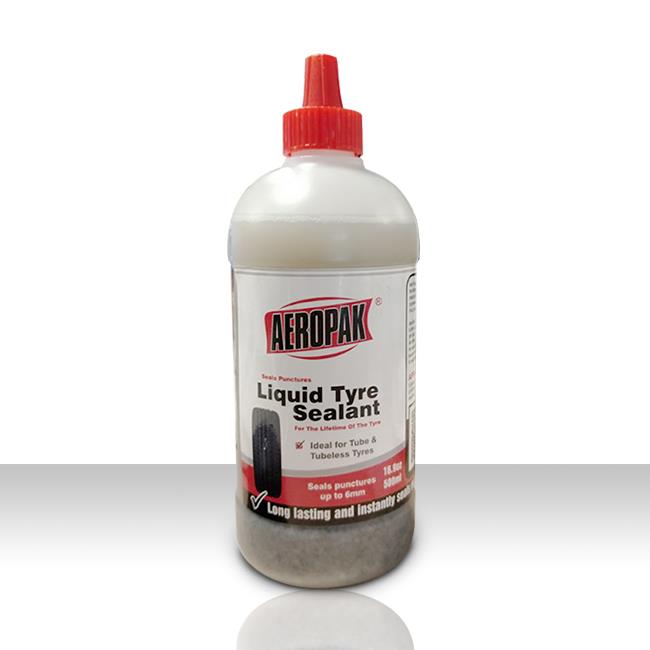
That said, Slime may be particularly good when you are dealing with punctures that have irregular edges and an odd shape, because of the way the long and short fibers bind together to plug up gaps.
Slime Sealant
Seals holes in tubeless tires and inner tubes up to 1/8″ (3mm) big. Works instantly and plugs up new punctures for up to 2 years.
Buy Now
From Amazon ( , save !)
So, Slime sealer does work on bike tires and it will provide a good fix for punctures most of the time. It is not perfect and it probably won’t last in the long term, so be aware that you may need to replace or repair the tire eventually.
However, it’s great for a quick and easy fix, especially when you’re not near your home or a bike shop, and it can also help to make your tires more durable. I do carry a bottle with me on long rides.
A car tire puncture is an unpredictable phenomenon. A spare or stowaway will of course help, but in some cases a faster method of troubleshooting may be required.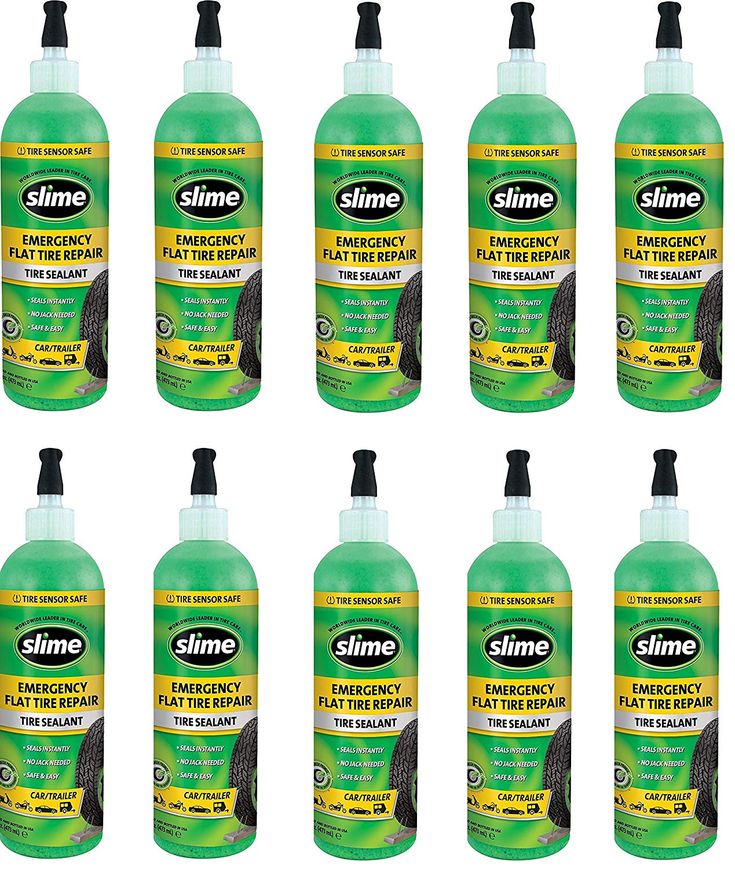 For girls, changing a wheel can be a serious test. In such situations, a special material - tire sealant - can become a reliable means of repairing a puncture.
For girls, changing a wheel can be a serious test. In such situations, a special material - tire sealant - can become a reliable means of repairing a puncture.
In most cases, tire sealant is an aerosol can containing a special chemical material that seals the tire from the inside.
The composition of the sealants are:
The latex sealant works from the inside of the tire. The material covers the inner surface, and getting to the place of breakdown, isolates it. Compositions based on synthetic or natural fibers are made on the basis of asbestos, polyethylene or paper. They, unlike latex sealants, act only at the puncture site itself.
By appointment means for tires are preventive and repair.
Means for preventive purposes are used in order to prevent a possible breakdown of rubber. A special sealing compound is fed through the nipple into the tire.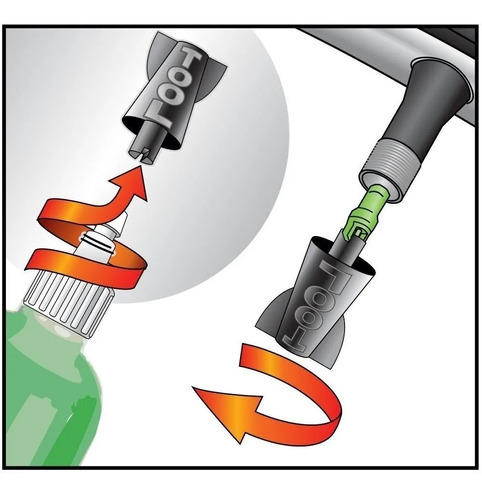
Under the influence of centrifugal force, which occurs when the vehicle is moving, the material is distributed over the inner surface of the tire.
When a tire breaks down, into which a preventive sealant is poured, there is no pressure drop in the wheel.
If the tire is with a chamber, then the composition is poured between the balloon and the tread layer. Due to the air cushion that is present in the wheels with the camera, heating can occur. Since the material withstands high temperatures, it contributes to the cooling of the tread. When using a preventive sealant in tubeless tires, the composition is distributed inside the wheel and prevents the occurrence of punctures and cracks.
Additional functions of sealants:
Repair sealants are used if a puncture has already formed and it is urgent to restore the integrity of the wheel in order to continue further movement.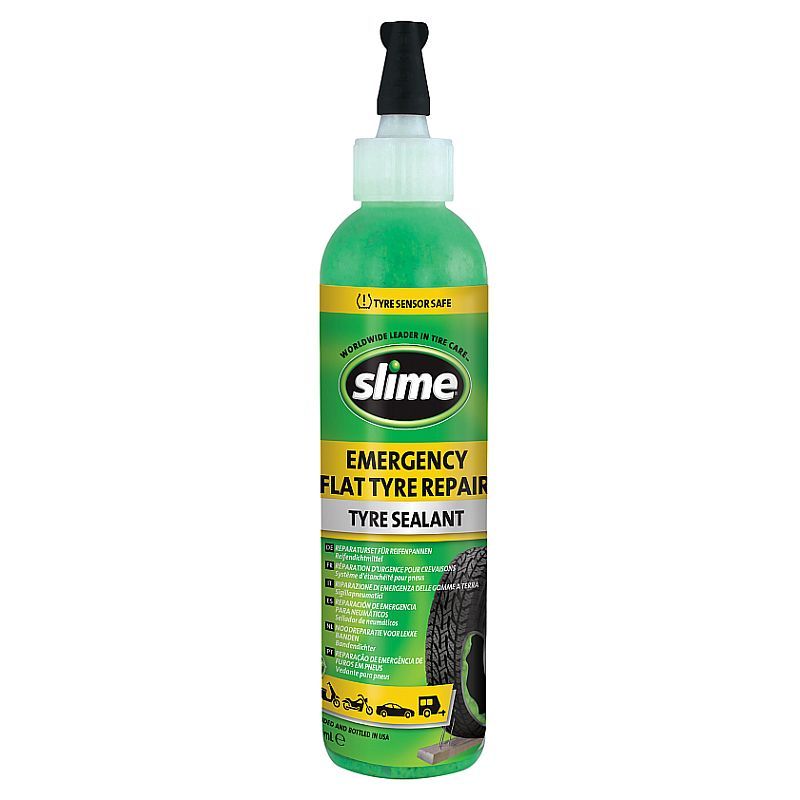
When the material is injected, the pressure in the tire increases and the tire takes shape. A film or liquid is formed inside the wheel, which, under the influence of centrifugal force, is evenly distributed inside the wheel and clogs the sample.
In addition to aerosols, there are materials in vials. They do not increase tire pressure, so the tire must be inflated after they are inflated. But such materials can be used with fully flat tires.
Repair sealants can only be used in tubeless tires. In tires with chambers, their use is unacceptable, since such material will simply glue the cylinder to the inner surface, and the wheel will become unusable.
There are a lot of tools for repairing punctured wheels on the market. In order to attract a potential buyer, manufacturers prescribe "tasty" properties to their products. But, if we put aside all marketing tricks, to select the optimal tool, you should pay attention to the following characteristics.![]()
Firstly, this is the purpose of the material. Aerosol wheel sealants, unlike those sold in bottles, have the additional function of increasing the pressure inside the tire. In terms of efficiency, it is impossible to say exactly which composition is better, but the ability to increase tire pressure can be indispensable, especially in cold or rainy weather.
The second is the operating temperature range of the sealant, namely frost resistance. At negative temperatures, some compounds crystallize, lose their properties and become completely useless.
An important role is played by the volume of the sealant. For example, 300 ml of spray is enough to eliminate a puncture in a small car tire, but this is not enough to repair an SUV wheel. Therefore, the dimensions of the installed tires should be taken into account.
This information is contained on the label or instructions for use.
Do not forget about the types of tires installed on the car. Different sealants are used for tubeless and tube tires, but there are also universal compounds that are suitable for both types.
Different sealants are used for tubeless and tube tires, but there are also universal compounds that are suitable for both types.
You also need to consider the number and size of punctures. Sealants can repair up to 6 punctures at the same time. At the same time, no composition will close up holes larger than 1 cm.
In addition to the above nuances, there are some difficulties that may arise when using a sealant.
Remember that the effect of tire adhesives is short-lived. Depending on the material, a retreaded wheel can be driven from 10 to 20 kilometers at a speed not exceeding 40-50 km/h.
To eliminate lateral damage with the help of such sealants will not work. It's all about centrifugal force, due to which the composition remains only in the projector area, and does not flow onto the side surfaces. Also, do not use sealants if the wheel is deformed.
If you are using aerosols that contain flammable gases, then the wheels should not be inflated with air.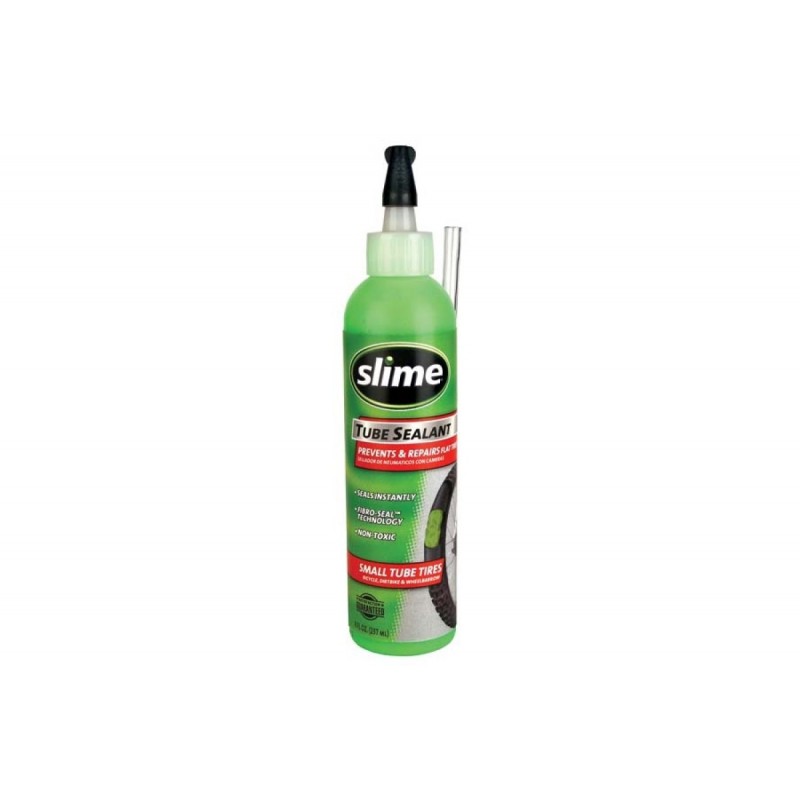 During driving, the rubber heats up and the mixture inside can ignite and explode.
During driving, the rubber heats up and the mixture inside can ignite and explode.
Repairing a wheel with sealants is not a difficult procedure. The main thing is to follow certain rules that depend on the material used.
First you need to remove the object that caused the puncture or, if it is not there, find a hole. Then you need to turn the wheel so that the damage is on top. With a completely flat tire, bleed off any remaining air.
The application of most sealants requires the removal of the spool, but with aerosols such manipulations are not necessary. Check the instructions for the material to see if the spool needs to be removed.
Next, you need to install the tip of the cylinder or tube into the valve and press on the valve. Repair can be considered completed as soon as the wheel becomes the desired shape. After that, you should measure the pressure in the tire, and, if necessary, bleed or inflate the wheel.
After a short trip (2-3 km) you need to check the tire pressure. This is due to the fact that some compounds are active for a long time. Therefore, in order not to drive on overinflated tires, it is important to know exactly what air density is in the wheels.
The procedure for working with a fluid sealant is almost the same as with an aerosol one. The main difference is that after pouring the product, the wheel must be turned several times and then pumped up to the desired pressure.
Tire sealant is very popular in the automotive chemicals market. This tool has appeared recently, but has already won many fans. With the help of sealant, you can quickly eliminate a hole in the wheel in order to easily get to the tire fitting.
Content:
There are various types of sealants on the market that are suitable for sealing bicycle and car inner tubes, as well as for repairing tubeless tires .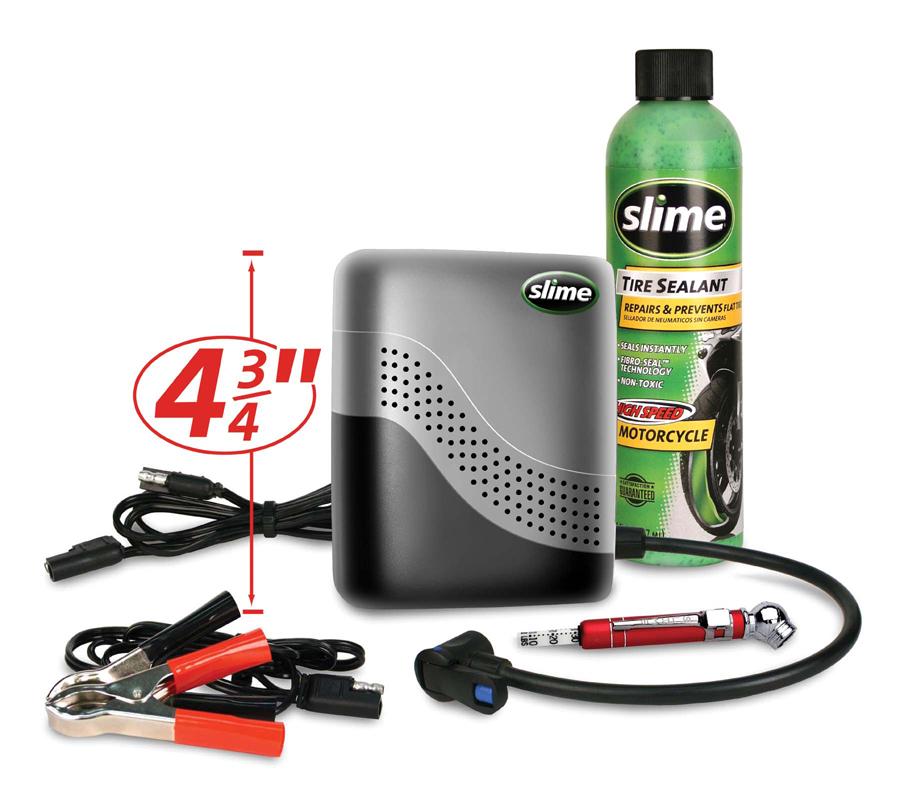 Depending on the composition, the puncture sealant can be:
Depending on the composition, the puncture sealant can be:
Most often, tire bead sealant is produced in cylinders filled with the main compound. Also, these products are produced in metal containers with a brush. Sometimes a set of a patch and a napkin soaked in a degreaser is attached to the sealant. According to the purpose, tire sealants can be divided into repair (emergency) and preventive.
back to contents ↑
You have to use these bead sealants when a wheel puncture has already happened, an urgent tire repair is required. Most compounds work with a completely flat tire, are introduced through a nipple. Repair sealants most often have an aerosol form with a tube tip, so applying them with your own hands is easy and convenient. Gradually, due to the increase in pressure, the tire begins to gain volume, restoring its normal shape, and foam is released from the punctured zones. The rest of the product in liquid form does not always need to be removed from the wheel, most often it is recommended to leave it to prevent new defects.
Most compounds work with a completely flat tire, are introduced through a nipple. Repair sealants most often have an aerosol form with a tube tip, so applying them with your own hands is easy and convenient. Gradually, due to the increase in pressure, the tire begins to gain volume, restoring its normal shape, and foam is released from the punctured zones. The rest of the product in liquid form does not always need to be removed from the wheel, most often it is recommended to leave it to prevent new defects.
back to contents ↑
These products are designed to prevent punctures in tube and tubeless tires. They are also poured through the nipple, and when the car moves, they are evenly distributed inside the tire under the action of centrifugal force. If a hole does happen, the pressure in the tubeless tire will remain the same, because the sealant will rush to the hole and seal it. In the presence of a chamber, the composition will be in an air cushion between the tread layer and the balloon, working in a similar way.
Some sealants have additional features:
The last mentioned property is due to the fact that the wheels with chambers are able to heat up due to the presence of an air gap, and the sealant cools the tread due to the low boiling point.
back to contents ↑
To purchase a really high-quality tire sealant, you need to consider the following recommendations:
 It is undesirable to install an already pierced chamber with preventive means: they have less strength than repair ones. You should also make sure that the sealant is suitable for the particular type of wheel. On sale you can find compounds that are suitable only for small cars and will not cope with the repair of an SUV wheel.
It is undesirable to install an already pierced chamber with preventive means: they have less strength than repair ones. You should also make sure that the sealant is suitable for the particular type of wheel. On sale you can find compounds that are suitable only for small cars and will not cope with the repair of an SUV wheel.
back to table of contents ↑
sealant All tire sealants come with a manufacturer's instructions that describe in detail the procedure.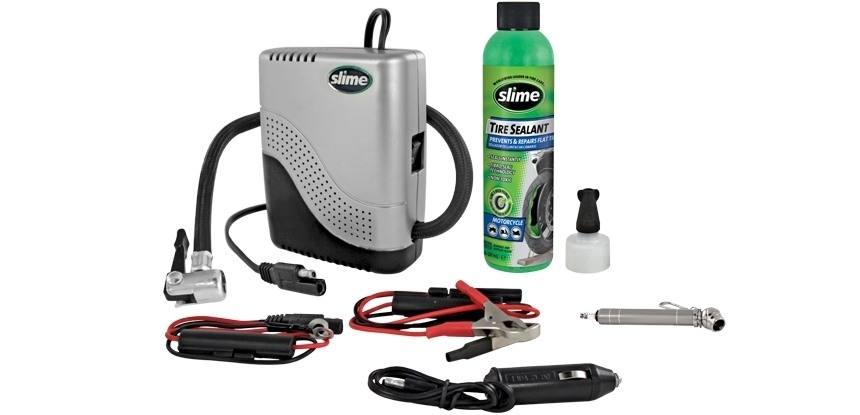 For most products, the steps are as follows:
For most products, the steps are as follows:
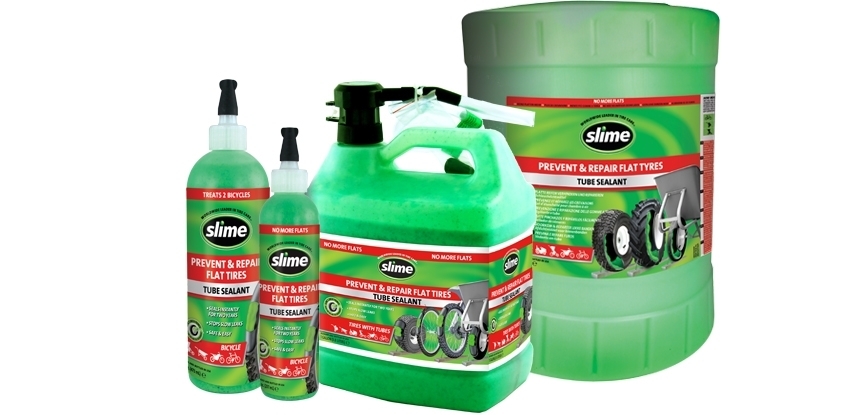
The first ten kilometers after the repair, it is necessary to move at low speed: this will help the compound to be better distributed inside the tire. After a minor damage, you can continue to use the wheel, and with a serious puncture, it is better to get to the car repair shop faster. You need to check the tire pressure again after 10-20 km to make sure that there is no pumping, because some sealants are active for a long time.
Tips for using sealant:
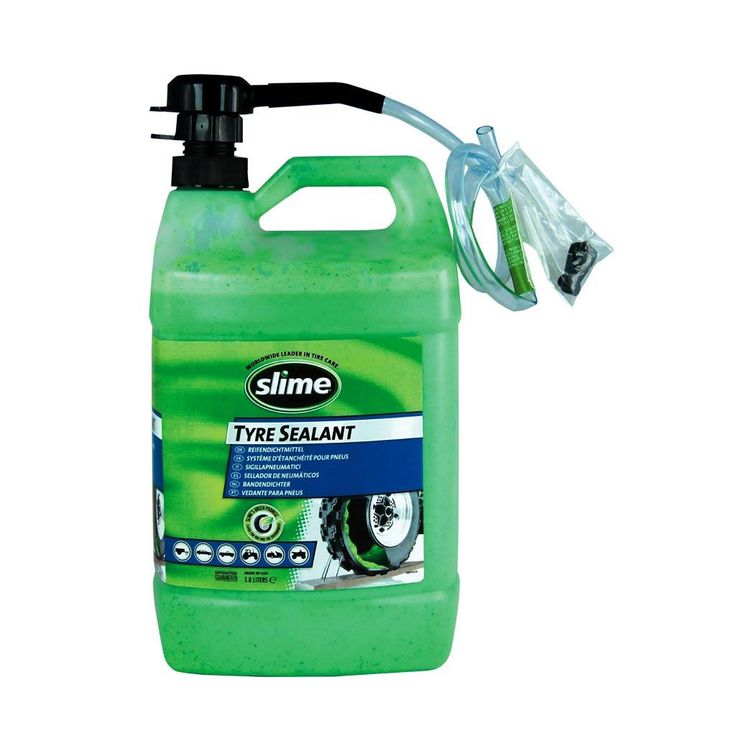
back to contents ↑
Some craftsmen make tire sealant from improvised means. Since almost all factory sealants are based on raw rubber (rubber), you will need to buy such material and dissolve it in gasoline. It is best to purchase imported rubber, which contains a minimum amount of impurities.
Any gasoline that is available will do, it is not necessary to purchase high-octane. Even kerosene, diesel fuel is suitable, although with gasoline the finished product will be of better quality. The exact proportions will have to be selected independently.
Next, cut the rubber into small pieces and gradually add gasoline so that the finished product has a semi-liquid consistency. Such a sealant can be poured into the tire or, if required, applied to the tire with a brush according to the type of lubricant.
to contents ↑
Among the variety of sealants for tires, you can get confused: such a large assortment is presented in stores.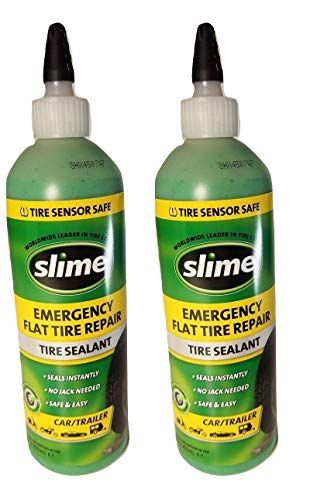 The following are quality compounds that will help repair a punctured wheel.
The following are quality compounds that will help repair a punctured wheel.
“Anti-Puncture” Sealant is a universal sealant suitable for the prevention and repair of holes. The package is enough to close ten punctures no more than 6 mm in diameter. The composition is suitable for tube and tubeless tires. For one wheel 14-15 inches you need 300-330 ml of the product, for 15-16 inches you need 360-420 ml. When repairing SUVs, trucks, you should purchase at least 480 ml of the product.
back to contents ↑
One of the most popular tire sealants, considered ideal for emergency repair of tubeless tires. Hi-Gear Tire Doctor can be used on the road, in case of a hole it will help you get to a car service. This American product is considered reliable, durable, but if possible, they should only seal small punctures.
Liqui Moly brand sealant is based on a rubber solution, excellent for tubeless, tube tyres.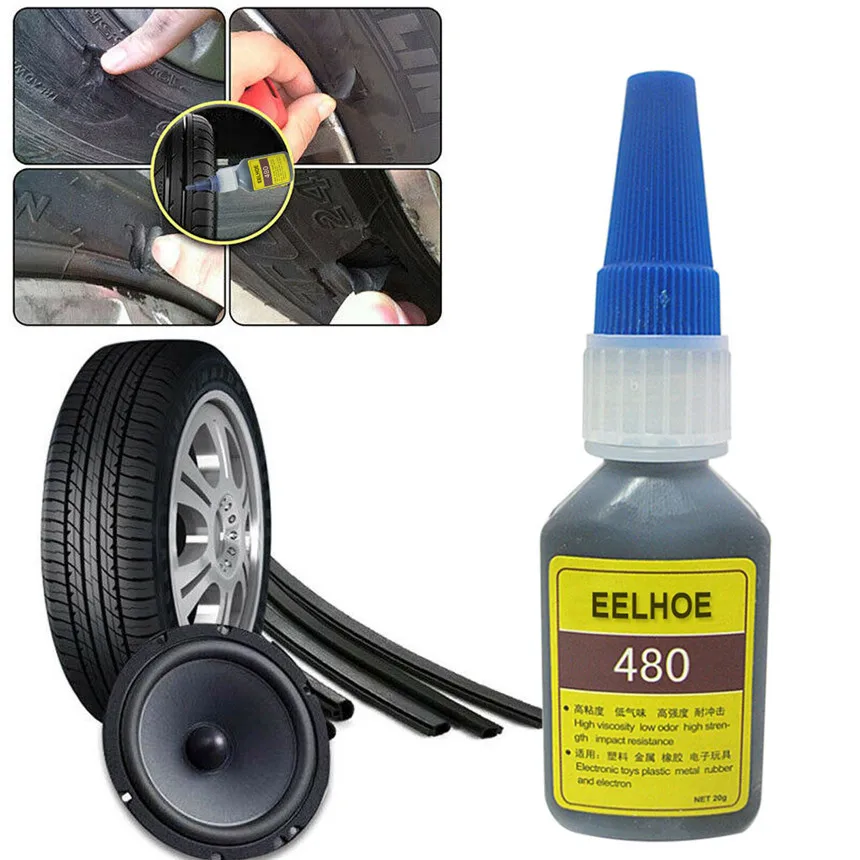 The composition in the form of a spray is odorless, safe for humans and the environment, it can be used even indoors. Due to the risk of fire, the product must not be handled near naked flames.
The composition in the form of a spray is odorless, safe for humans and the environment, it can be used even indoors. Due to the risk of fire, the product must not be handled near naked flames.
This brand of repair compound is designed to repair punctured, cut tires. One bottle is enough for a 16" wheel. When introduced, the rubber compound fills in existing defects, and the remaining mixture becomes the prevention of new cuts, continuing to remain inside the tire. The sealant creates high pressure, which reduces the risk of a flat tire on the road. The disadvantage of the tool is this - it causes some imbalance of the wheels, so after the repair it is better to check the car in the service.
back to contents ↑
The sealant is used for car tires and is not suitable for repairing bicycle and motorcycle inner tubes. It quickly seals small punctures on tires up to 16 inches in diameter. The tool can be used for tubeless and chamber tires, but the efficiency when working with the former is much higher. In cold weather, the sealant must be warmed up well, otherwise the quality of the repair will decrease.
The tool can be used for tubeless and chamber tires, but the efficiency when working with the former is much higher. In cold weather, the sealant must be warmed up well, otherwise the quality of the repair will decrease.
Considered to be the most popular tire solution for trucks, SUVs and heavy equipment. Its packaging is enough to process a tire with a diameter of 22 inches. The tool is suitable for machines where an automatic pressure control sensor is installed. The quality of the Japanese product is very high, the sealing properties are serious, but the cost cannot be called budgetary.
Inexpensive on-road repair of tubeless tires. It helps to inflate the wheel to a pressure of 1.4 atmospheres and get to the service without any problems. The sealant is available in the form of an aerosol in a convenient container with a hose, it is comfortable and easy to work with it.
back to contents ↑
Effective sealant, allows sealing holes up to 6 mm in diameter. Suitable for old wheels with tubes and tubeless tires. MANNOL Reifen Doctor acts quickly, sets in just a minute, is safe for steel wheels, does not provoke the development of corrosion. Inside the tire, the sealant will be in liquid form, but upon contact with air it immediately polymerizes, therefore it can also be used to prevent punctures. Minus means - low pressure after repair, the need for additional inflation of the wheel with a pump or compressor. The maximum puncture size for sealing is 6 mm.
Suitable for old wheels with tubes and tubeless tires. MANNOL Reifen Doctor acts quickly, sets in just a minute, is safe for steel wheels, does not provoke the development of corrosion. Inside the tire, the sealant will be in liquid form, but upon contact with air it immediately polymerizes, therefore it can also be used to prevent punctures. Minus means - low pressure after repair, the need for additional inflation of the wheel with a pump or compressor. The maximum puncture size for sealing is 6 mm.
back to contents ↑
The setting time of this product is also minimal - 1-2 minutes, it is suitable for cars, trucks and other vehicles. The price of the sealant is low, but it serves as a temporary remedy until a visit to the tire shop, and the maximum driving speed should not exceed 20 km / h.
Latex-based sealant, has a temporary effect until a trip to a car service.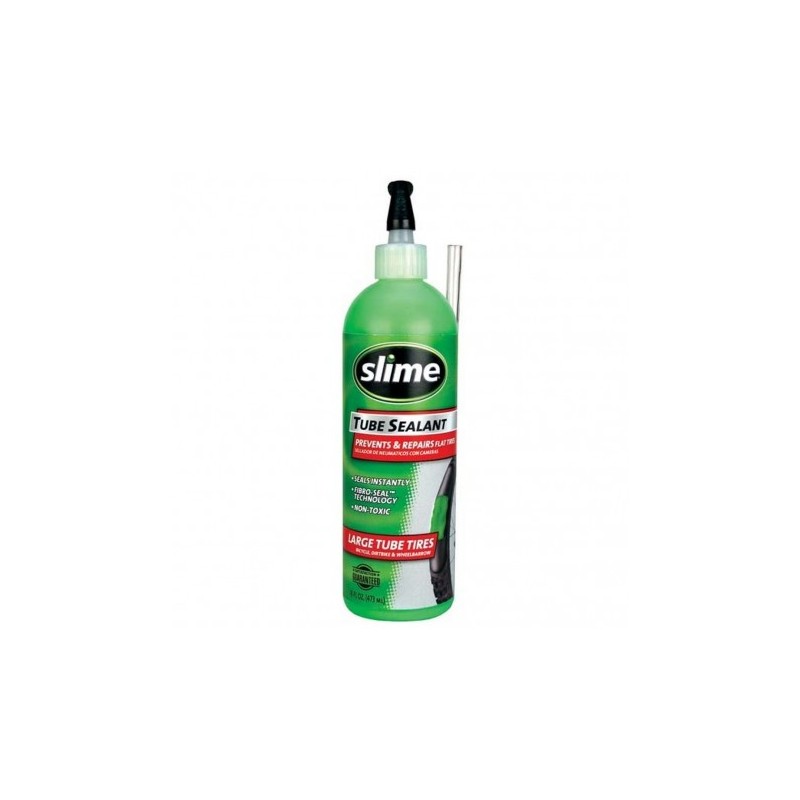 After the bay, you need to drive at least 5 km at a speed of 35 km / h in order to distribute the compound on the inner surface of the tire. The sealant will not cope with large punctures, so it is not suitable for holes larger than 4-6 mm in diameter.
After the bay, you need to drive at least 5 km at a speed of 35 km / h in order to distribute the compound on the inner surface of the tire. The sealant will not cope with large punctures, so it is not suitable for holes larger than 4-6 mm in diameter.
back to contents ↑
Runway Sealant is suitable for motorcycle, bicycle and car tyres. It is sold in a can with an extension hose, the volume of which is 650 ml, which is enough to repair two wheels. Due to the nature of the composition, do not allow the product to come into contact with the skin or mucous membranes!
back to contents ↑
Easy to use, fast and effective product. It is completely safe and non-toxic, easily copes with holes and cracks up to 5 mm in size, suitable for trucks, cars and bicycles. Sealant is ideal for use on the road as an emergency tool, although the "patch" made by him will be quite durable.
Sealant produced by one of the most famous brands of tires, adapted to all car tires. It is based on latex, while there are no harmful additives, toxic impurities. In addition to safety for humans, the sealant is characterized by the absence of a destructive effect on the wheels. The composition allows you to do without a spare tire, carrying out repairs in emergency conditions.
back to contents ↑
This American made product is valued by consumers for its high quality. It copes well with tire damage, has a more liquid texture than analogues, so it quickly spreads over the inner surface of the tire. The effectiveness and long service life of the sealant (up to 7 months) are due to the presence of natural rubber and composite microcrystals in the composition.
Repairs tire punctures up to 1 cm in diameter, sealing air leaks by forming a "plug".